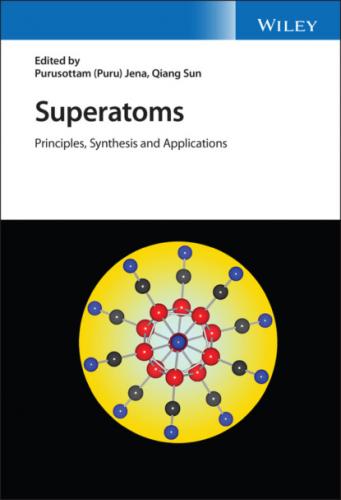Source: Dognon et al. [60]. © John Wiley & Sons.
2.2.5 Aromaticity Rule
Aromaticity rule was developed by Huckel [12, 13, 69] to account for the stability of planar conjugated molecules such as C6H6. Based on a molecular orbital theory, it was shown that planar conjugated monocyclic polyene that has (4n + 2) (n = 0, 1, 2, . . . ) π or nonbonding electrons will be aromatic and stable. For benzene, n = 1. Because of the high stability, the aromatic molecules have low electron affinities, which seldom exceed 1.17 eV. Indeed, the electron affinity of C6H6 is −1.29 eV [70]. Jena and coworkers [71, 72] showed that the aromaticity rule can be used to design superatoms with electron affinities that can even exceed the electron affinity of Cl. This is accomplished by replacing H atoms in C6H6 by more electronegative atoms as well as by changing composition of the hexagonal core. In Figures 2.19 and 2.20, we show the globally optimized geometries of C6H6 − x F x and BC5H6 − x F x (x = 1–6) computed by Driver and Jena [73] using density functional theory. The corresponding electron affinities are given in Table 2.2. Note that the electron affinities of C6H6 − x F x and BC5H6 − x F x steadily increase with x. The computed electron affinity, 0.75 eV of C6F6 agree well with the experimental value of 0.86 ± 0.03 eV [74, 75]. Realizing that the electron affinity of C5H5, which lacks one electron to be aromatic, is +1.80 eV, Jena and coworkers replaced one of the C atoms in C6H6 by a B atom. The resulting BC5H6 lacks one electron to be aromatic, and its electronic affinity of 2.31 eV is indeed high. Further replacement of H atoms by F atoms allows the electron affinity to rise systematically, reaching a value of 3.24 eV for BC5F6. Thus, an aromatic molecule can mimic the chemistry of a halogen atom by suitable tailoring of its core and/or the ligand atoms.
Figure 2.19 Ground state geometries of neutral and anionic C6H6 − xFx. The gray, white, and blue spheres correspond to carbon, hydrogen, and fluorine, respectively.
Source: Driver and Jena [73]. © John Wiley & Sons.
The aromaticity rule has been extended to inorganic systems, providing further opportunities to design a new class of superatoms. One of these is an all‐metal cluster, MAl4 − (M = Li, Na, Cu). Using experiment and ab initio calculations, Li et al. [76] compared the measured photoelectron spectra with theory. The computed geometries of the MAl4 − clusters (see Figure 2.21) are found to be pyramidal with the metal atom M at the apex carrying +1 charge and interacting with a square Al4 2− moiety. Note that the geometry of an isolated Al4 2− is also a square, although it is unstable against spontaneous emission of the second electron. The HOMO of MAl4 −, as well as that of Al4 2−, was found to be doubly occupied and composed of a delocalized π orbital, with other molecular orbitals being either σ‐type or lone pairs. The presence of two valence electrons is characteristic of Huckel aromaticity, with n = 0.
Figure 2.20 Ground state geometries of neutral and anionic C5BH6 − xFx. The gray, white, pink, and blue spheres correspond to carbon, hydrogen, boron, and fluorine, respectively.
Source: Driver and Jena [73]. © John Wiley & Sons.
Table 2.2 Electron affinities (in eV) of ground state molecules.
| x | C6H6 − x F x | BC5H6 − x F x | C6H6 − x (BO2) x | BC5H6 − x (BO2) x | C6H6 − x (CN) x |
|---|---|---|---|---|---|
| 0 | −1.29 | 2.31 | −1.15 | 2.31 | −1.29 |
| 1 | −0.93 | 2.28 | −0.75 | 2.78 | 0.09 |
| 2 | −0.62 | 2.56 | −0.38 | 2.72 | 1.06 |
| 3 | −0.42 | 2.93 | 0.79 | 3.24 | 1.70 |
| 4 | 0.01 | 2.91 | 1.22 | 3.12 | 2.44 |
| 5 | 0.45 | 3.15 | 1.67 | 3.93 | 3.11 |
| 6 | 0.75 | 3.24 | 1.80 | 3.65 | 3.49 |
Figure 2.21 Left panel: photoelectron spectra at 355 nm (3.496 eV) for (a) LiAl4−, (b) NaAl4−, and (c) CuAl4− and at 266 nm (4.661 eV) for (d) LiAl4−, (e) NaAl4−, (f) CuAl4−, and (g) square planar Al42– cluster. Right panel: optimized structures of LiAl4−, NaAl4−, Al42− [at the CCSD(T)/6‐311+G* level of theory], and CuAl4−.
Source: Li et al. [76]. © American Association for the Advancement of Science.
2.2.6 Wade‐Mingos Rule
